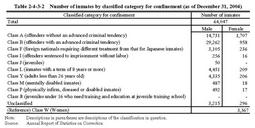| Previous Next Index Image Index Year Selection | |
|
|
1 Basic systems There are the Classified Treatment System and the Progressive Treatment System as basic systems for the treatment of inmates.Furthermore, Open Treatment is adopted,depending on the nature of inmates.
Fig.2-4-3-1 shows the flow of treatment of an inmate in a penal institution. Fig.2-4-3-1 Flow of treatment of an inmate (1) Classified Treatment The treatment of inmates in penal institutions aims at the correction of inmates for their smooth social rehabilitation.In order to achieve this,treatment is implemented in response to the characteristics of individual inmates including the reasons for their committing offenses through scientific diagnosis of their personalities.Scientific surveys to identify the problems of individual inmates are called classifying examination s,and classification treatment includes preparing treatment plans based on these examinations results,organizing groups of inmates,and carrying out effective treatment for each group.This is called the Classified Treatment System.
Classifying examinations are conducted,on entry or when necessary,on the basis of expertise and technology in medicine,psychology,education,sociology,and others.The result of classifying examinations is used for appropriate confinement and treatment,including determination of classified categories(for confinement and for treatment)and allocation of cells,decision of treatment guidelines for security,prison work,education program etc.,examinations for progressive treatment,and applications for parole. As one of the measures to improve Classified Treatment,special institutions are designated as classification centers in each of the Regional Correction Headquarters.Classification centers make the examinations of(i)newly imprisoned male inmates under16year of age whose term of imprisonment is three months or more and(ii)newly imprisoned male inmates16years and over but under28years of age,whose term of imprisonment is one year or more,and who have never been imprisoned before(excluding those clearly classified into Class F). Based on the result of classifying examinations,a category for confinement(criteria to classify a facility or division therein in which the offender is to be accommodated;hereinafter the same)and a category for treatment(criteria to classify a prior policy of treatment for the inmate;hereinafter the same)are identified,and the facility for the inmate to be accommodated in is then determined based on the category for confinement. Table2-4-3-2 shows the number of inmates in each classified category for confinement as of December31,2004. Table2-4-3-2 Number of inmates by classified category for confinement(as of December31,2004) Table2-4-3-3 shows the number of inmates in each classified category for treatment as of December31,2004.Those inmates classified in Class G,who need daily life guidance,accounted for more than60%.There have been no changes in this trend in recent years.Table2-4-3-3 Number of inmates by classified category for treatment(as of December31,2004) (2) Progressive Treatment The Progressive Treatment System is a system in which the process of execution of the sentence is divided into four grades(Grades1to4)and an inmate gradually progresses from the bottom grade(Grade4)to higher grades,depending on his/her attitude and behavior.Accordingly,he/she is gradually given privileges and responsibilities in external communications,etc.Progressive treatment is implemented in all penal institutions.
(3) Open Treatment The Open Treatment System is a form of treatment for ensuring discipline through the inmate's responsibility and self-governing restrictions as a substitute for the use of locks and other physical facilities and equipment as well as supervision by staff to ensure confinement.It aims to provide effective treatment for social rehabilitation in an environment as similar to ordinary social life as possible,and is mainly implemented in penal institutions housing traffic offenders.Open treatment is also implemented in a developed form of outside work in Futamigaoka Farm(affiliated with Abashiri Prison)and Ooi Shipbuilding Workshop(affiliated with Matsuyama Prison),etc.
|


